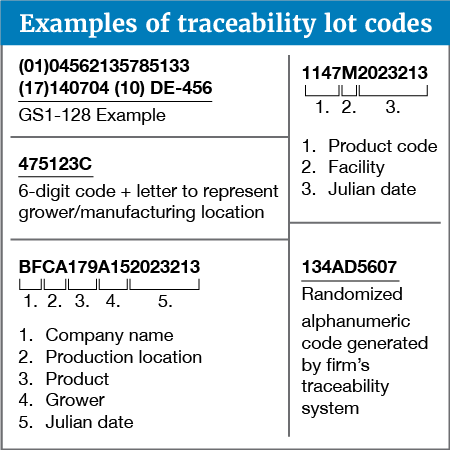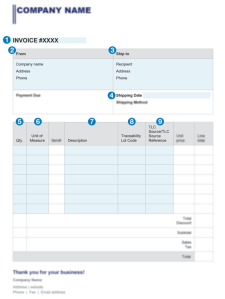Traceability Lot Code
The goal of the Food Traceability rule is to ensure Key Data Elements (KDEs) can be maintained across the supply chain for more efficient and effective tracing while providing firms flexibility within their existing tracing systems.
The traceability lot code (TLC) is an integral component of the rule’s requirements. It links to the other KDEs required, including the TLC Source, which provides the physical location where the traceability lot code for an FTL food was assigned.
Requiring documentation of traceability lot codes and traceability lot code sources enables FDA to identify the source of the food faster – by enabling FDA to skip steps in the supply chain, link a food to the firms that have handled it, and ultimately lead FDA back to the source of the food during an outbreak investigation.
Here’s a closer look at traceability lot code, traceability lot code source, and traceability lot code source reference.
What is a traceability lot code?
A traceability lot code means a descriptor, often alphanumeric, used to uniquely identify a traceability lot within the records of the traceability lot code source (defined below). This is similar to what industry currently refers to as a ‘lot’ or ‘lot code’.
Unless the relevant entity is exempt from the rule, the traceability lot code is assigned when the food is initially packed (for raw agricultural commodities not obtained from a fishing vessel), received by the first land-based receiver (for food obtained from a fishing vessel), or transformed. Once a TLC is assigned, it must stay the same as the food moves through the supply chain; it can only be changed if the food is transformed.
What are some examples of traceability lot codes?
Several food industry-supported traceability initiatives offer best practices and standards for uniquely identifying a lot of food using a combination of a globally unique product identifier, firm-assigned internal lot code, and standard date code. Other examples include a Julian date, a lot code, batch code or other production code. This information, taken together, could be used as a traceability lot code, provided it meets the definition of “traceability lot code” in the final rule. Some examples of traceability lot codes are below:
Traceability Lot Code Source
What is a traceability lot code source?
A traceability lot code source refers to the physical location where a food was assigned a traceability lot code. In certain situations, the Food Traceability Rule requires documentation of either the location description for the traceability lot code source, or the traceability lot code source reference.
Location description means key contact information for the location where a food is handled, specifically the business name, phone number, physical location address (or geographic coordinates), and city, State, and zip code for domestic locations and comparable information for foreign locations, including country. Therefore, the location description for a traceability lot code source would be this key contact information for the place where the food was assigned a traceability lot code.
What is an example of a location description for a TLC source?
One example could look like this:
FreshFood, Inc.
123 Main Street
Anytown, PA 19123
(555) 123-9876
Traceability Lot Code Source Reference
What is a traceability lot code source reference?
A traceability lot code source reference means an alternative method for providing FDA with access to the location description for the traceability lot code source. Examples of a traceability lot code source reference include, but are not limited to, the FDA Food Facility Registration Number for the traceability lot code source or a web address that provides FDA with the location description for the traceability lot code source.
What are some examples of a traceability lot code source reference?
If a firm chooses to use a traceability lot code source reference, they can set it up in a way that will maintain the confidentiality of business information concerning suppliers. For example, if the firm uses a web address as the traceability lot code source reference, the associated website may employ reasonable security measures, such as only being accessible to a government email address, provided that FDA has access to the information at no cost and without delay. Two examples are below:
TLC Source Reference example:
FDA Food Facility Registration Number:
#11111111111
TLC Source Reference example:
Web address:
www.freshfoodinc.com/rQyw62dz3
Why is this information important?
Requiring documentation of traceability lot codes and traceability lot code sources enables FDA to get to the source of the food faster – by enabling FDA to skip steps in the supply chain, link a food to the firms that have handled it, and ultimately lead FDA back to the source of the food during an outbreak investigation.
Traceability lot codes (TLC) help ensure accurate identification of the food as it moves through the supply chain, and the TLC Source provides the physical location where the traceability lot code for an FTL food was assigned. Both of these KDEs will improve our ability to identify the specific food and location involved in a contamination event and determine the appropriate scope of a recall event.
What else do I need to know?
How should firms define a traceability lot?
The Food Traceability Rule does not prescribe a specific way firms must define a traceability lot; rather the rule provides firms with flexibility in how they determine what constitutes a traceability lot. We note that smaller traceability lots might lead to less food being affected in the event of a recall.
The rule does require that a TLC and the other required Key Data Elements (KDEs) must be linked to each traceability lot. Linkages can be achieved by having the traceability lot code appear on the reference documents the firm keeps to document the required KDEs. For example, the traceability lot code could appear on a bill of lading or invoice, which also contains other KDEs. For firms that maintain records electronically, linkage could be achieved by including the traceability lot code in the same row of a spreadsheet or database that documents the required KDEs for a tracking event.
How should firms define a traceability lot code?
The Food Traceability Rule does not prescribe a specific way firms must assign a TLC. Within your Traceability Plan, a firm must provide a description of the process used to assign a TLC (e.g., Julian date plus product code, randomized generated code, etc.) to foods on the Food Traceability List, if applicable.
When must firms assign a traceability lot code?
Firms must assign a traceability lot code when they:
-
Initially pack a raw agricultural commodity (RAC) other than a food obtained from a fishing vessel;
-
Perform the first land-based receiving of a food obtained from a fishing vessel; or
-
Transform a food.
Firms must not establish a new traceability lot code when they conduct any other activities (e.g., shipping). However, if you receive a food from a person who is exempt from the rule, you must assign a traceability lot code (unless you are a retail food establishment or restaurant) - 21 CFR 1.1345(b).
Do I need to include the TLC on the product label or product packaging?
No, the final rule does not require that the TLC be included on food labeling or food packaging. The TLC could be sent to the next recipient of the food in a variety of ways, such as via a bill of lading, an advance shipment notice (ASN), in a separate email, or by embedding the information in a quick response (QR) code that appears on the packaging of the food or on a related document. The information would not have to physically accompany the food sent to the recipient but must be provided in a way that permits the receiver of the food to keep the records it is required to maintain under the rule.
Traceability Lot Code Examples
(PDF: 398KB)
For More Information
For examples of how the TLC and the location description for the TLC source (or the TLC source reference) could appear on an invoice or bill of lading, see the following examples. These examples are for illustrative purposes only and are not the only way these Key Data Elements could be presented. While these examples contain all the required Shipping KDEs for the purposes of illustration, 21 CFR 1.1455(g) states that you do not have to keep all of the information required by the rule in a single set of records. However, your traceability plan must indicate the format and location of the records you are required to keep under the rule, in accordance with § 1.1315(a)(1).


